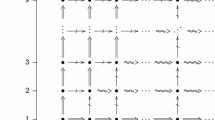Abstract
Nilsystems are a natural generalization of rotations and arise in various contexts, including in the study of multiple ergodic averages in ergodic theory, in the structural analysis of topological dynamical systems, and in asymptotics for patterns in certain subsets of the integers. We show, however, that many natural classes in both measure preserving systems and topological dynamical systems contain no higher order nilsystems as factors, meaning that the only nilsystems they contain as factors are rotations. Our main result is that in the topological setting, nilsystems have a particular type of complexity of polynomial growth, where the polynomial (with explicit degree) is an asymptotic both from below and above. We also deduce several ergodic and topological applications of these results.
Similar content being viewed by others
References
L. Auslander, L. Green, and F. Hahn, Flows on Homogeneous Spaces, Princeton University Press, Princeton, N.J., 1963.
V. Bergelson, Weakly mixing PET, Ergodic Theory Dynam. Systems 7 (1987), 337–349.
V. Bergelson, B. Host, and B. Kra, with an appendix by I. Ruzsa, Multiple recurrence and nilsequences, Invent. Math. 160 (2005), 261–303.
V. Bergelson, A. Leibman, and E. Lesigne, Intersective polynomials and the polynomial Szemerédi theorem, Adv. Math. 219 (2008), 369–388.
F. Blanchard, B. Host, and A. Maass, Topological complexity, Ergodic Theory Dynam. Systems 20 (2000), 641–662.
X. Bressaud, F. Durand, and A. Maass, On the eigenvalues of finite rank Bratteli-Vershik dynamical systems, Ergodic Theory Dynam. Systems 30 (2010), 639–664.
Q. Chu, Convergence of weighted polynomial multiple ergodic averages, Proc. Amer. Math. Soc. 137 (2009), 1363–1369.
F. Durand, Linearly recurrent subshifts have a finite number of non-periodic subshift factors, Ergodic Theory Dynam. Systems 20 (2000), 1061–1078.
P. Dong, S. Donoso, A. Maass, S. Shao, and X. Ye, Infinite-step nilsystems, independence and complexity, Ergodic Theory Dynam. Systems 33 (2013), 118–143.
S. Ferenczi, Systèmes localement de rang un, Ann. Inst. H. Poincaré Probab. Statist. 20 (1984), 35–51.
S. Ferenczi, Systèmes de rang un gauche, Ann. Inst. H. Poincaré Probab. Statist. 21 (1985), 177–186.
S. Ferenczi, Rank and symbolic complexity, Ergodic Theory Dynam. Systems 16 (1996), 663–682.
S. Ferenczi Measure-theoretic complexity of ergodic systems, Israel J. Math. 100 (1997), 189–207.
N. Frantzikinakis, Multiple ergodic averages for three polynomials and applications, Trans. Amer. Math. Soc. 360 (2008), 5435–5475.
N. Frantzikinakis, Multiple recurrence and convergence for Hardy field sequences of polynomial growth, J. Anal. Math. 112 (2010), 79–135.
N. Frantzikinakis and B. Kra, Ergodic averages for independent polynomials and applications, J. Lond. Math. Soc. (2) 74 (2006), 131–142.
N. Frantzikinakis and M. Wierdl, A Hardy field extension of Szemerédi’s theorem, Adv. Math. 222 (2009), 1–43.
R. Gjerde and Ø. Johansen, Bratteli-Vershik models for Cantor minimal systems associated to interval exchange transformations, Math. Scand. 90 (2002), 87–100.
B. Green and T. Tao, Linear equations in primes, Ann. of Math. (2) 171 (2010), 1753–1850.
B. Host and B. Kra, Nonconventional ergodic averages and nilmanifolds, Ann. of Math. (2) 161 (2005), 397–488.
B. Host and B. Kra, Convergence of polynomial ergodic averages, Israel J. Math. 149 (2005), 1–20.
B. Host and B. Kra, Uniformity seminorms on ℓ ∞ and applications, J. Anal. Math. 108 (2009), 219–276.
B. Host, B. Kra, and A. Maass, Nilsequences and a topological structure theorem, Adv. Math. 224 (2010), 103–129.
A. Katok and J.-P. Thouvenot, Slow entropy type invariants and smooth realization of commuting measure-preserving transformations, Ann. Inst. H. Poincaré Probab. Statist. 33 (1997), 323–338.
A. Leibman, Polynomial sequences in groups, J. Algebra 201 (1998), 189–206.
A. Leibman, Pointwise convergence of ergodic averages for polynomial sequences of translations on a nilmanifold, Ergodic Theory Dynam. Systems 25 (2005), 201–213.
A. Leibman, Convergence of multiple ergodic averages along polynomials of several variables, Israel J. Math. 146 (2005), 303–316.
A. Malcev, On a class of homogeneous spaces, Amer. Math. Soc. Transl. 1951 (1951), no. 39.
D. Ornstein, D. Rudolph, and B. Weiss, Equivalence of measure preserving transformations, Mem. Amer. Math. Soc. 37 (1982), no. 262.
W. Parry, Dynamical systems on nilmanifolds, Bull. London Math. Soc. 2 (1970), 37–40.
M. Queffélec, Substitution Dynamical Systems — Spectral Analysis, second edition, Springer-Verlag, Berlin, 2010.
S. Shao and X. Ye, Regionally proximal relation of order d is an equivalence one for minimal systems and a combinatorial consequence, Adv. Math. 231 (2012), 1786–1817.
A. N. Starkov Dynamical Systems on Homogeneous Spaces, American Mathematical Society, Providence, RI, 2000.
A.M. Stepin, Flows on solvable manifolds, Upekhi Mat. Nauk 24 (1969), 241–242.
P. Walters, An Introduction to Ergodic Theory, Springer-Verlag, New York-Berlin, 1982.
H. Weyl, Úber die Gleichverteilung von Zahlen mod Eins, Math. Ann. 77 (1916), 313–352.
Author information
Authors and Affiliations
Corresponding author
Additional information
Partially supported by NSF grant 1200971
Partially supported by Fondap 15090007 and CMM-Basal grants.
Rights and permissions
About this article
Cite this article
Host, B., Kra, B. & Maass, A. Complexity of nilsystems and systems lacking nilfactors. JAMA 124, 261–295 (2014). https://doi.org/10.1007/s11854-014-0032-7
Received:
Published:
Issue Date:
DOI: https://doi.org/10.1007/s11854-014-0032-7



